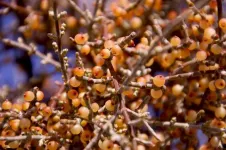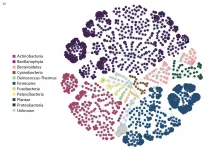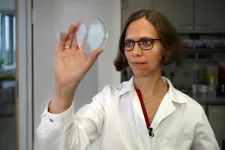(Press-News.org) The plant that encourages kissing at Christmas is in fact a parasite, and new research reveals mistletoe has an unusual feeding strategy.
Like other plants, mistletoe is capable of using sunlight to create its own food, a process called photosynthesis. However, it prefers to siphon water and nutrients from other trees and shrubs, using "false roots" to invade its hosts.
"Plants are autotrophic, they make their own food. Humans are heterotrophic, we eat it," explained UC Riverside plant-insect ecologist Paul Nabity. "Mistletoe are mostly heterotrophic, but they can switch if they want to."
Nabity's team found when two mistletoes invade the same tree, they increase photosynthesis to get the nutrients they need, essentially sharing the tree and causing it less harm.
"They seem to know when they're attacking the same host, and can reduce the virulence of their attack," Nabity said.
A new paper describing this finding was published today in the journal Current Biology.
The Christmas mistletoe is a European species that tends to attack apple and other hardwood trees in central California. For this experiment, the researchers examined a native species of mistletoe found throughout the Sonoran and Mojave deserts that often grows on acacia, palo verde or mesquite trees.
When researchers removed one of two mistletoes from a branch, they saw the plant left behind did not increase its photosynthesis, and in some cases reduced its water intake.
"It appears that the remaining mistletoe recognized it was no longer competing for resources," Nabity said.
Often times, birds feed from and guard a fruiting mistletoe and in the process, defecate seeds into the same tree from which they came. A tree full of related mistletoes increases the parasite load for the host, though the infection may not be as severe as it otherwise would be if infected with unrelated plants.
Nabity, who studies interactions between plants and insects, explained that communication among mistletoes is possible through a variety of methods. They are connected to a host's xylem, the tissue that trees use to move water and nutrients from the roots. It's possible the mistletoes send messages using the xylem. It's also possible they may "smell" one another.
Plants produce chemical compounds and release them through their pores. These compounds evaporate quickly into the air, sending signals that can be received down wind.
However it is that mistletoes communicate, Nabity says they don't necessarily need to be removed from infected trees.
Forest managers have long maintained that removal will increase tree health. Though this may be true for an individual tree, mistletoe has an important role ecologically, benefitting birds and pollinators. It tends to flower in winter when nectar or pollen from many other plants is not yet available.
Not only does mistletoe help other species, it may not hurt trees or shrubs as much as once feared.
"Don't remove mistletoe because you think they're all bad," he said.
INFORMATION:
Kittens could be the model for understanding infectious, sometimes deadly, diarrheal disease in both animals and children, according to new research from North Carolina State University.
Diarrheagenic Escherichia coli (DEC) bacteria cause lethal diarrheal disease in children worldwide, killing up to 120,000 children under the age of five annually. Atypical enteropathic Escherichia coli (aEPEC) are a form of DEC increasingly associated with diarrheal disease in humans and in kittens.
"We were looking for causes of infectious diarrhea in kittens, which has a high mortality rate, and came across this pathogen," says Jody Gookin, FluoroScience Distinguished Professor in Veterinary Scholars Research Education at NC State and corresponding ...
Building upon previous research, an international team led by scientists at University of California San Diego School of Medicine, has validated a more inclusive and comprehensive genetic tool for predicting age of onset of aggressive prostate cancer, a disease that killed more than 33,000 American men in 2020.
Reporting in the February 23, 2021 online edition of Nature Communications, the researchers describe the performance of a polygenic hazard score (PHS) -- a mathematical estimate of an individuals' age-specific genetic risk for developing a disease -- in a multi-ethnic patient population.
"Genetic tools to predict a man's lifetime risk of prostate cancer might allow us to target cancer screening efforts to the men who are most likely to need it. We are ...
MINNEAPOLIS/ST.PAUL (02/23/2021) -- University of Minnesota Medical School researchers have developed two new rapid diagnostic tests for COVID-19 - one to detect COVID-19 variants and one to help differentiate with other illnesses that have COVID-19-like symptoms. The findings were recently published in the journal Bioengineering.
Although many people are hopeful about COVID-19 vaccines, widespread vaccine distribution isn't predicted to be available until several months from now. Until that happens, the ability to diagnose COVID-19 quickly and accurately is crucial to help minimize loss of life and ...
Shipping traffic can be a major source of tiny plastic particles floating in the sea, especially out in the open ocean. In a paper published in the scientific journal Environmental Science & Technology, a team of German environmental geochemists based at the University of Oldenburg's Institute of Chemistry and Biology of the Marine Environment and led by Dr Barbara Scholz-Boettcher for the first time provides an overview of microplastics mass distribution in the North Sea.
The scientists found that most of the plastic particles in water samples taken from the German Bight, an area in the south-eastern corner of the North Sea which encompasses some of the world's busiest shipping lanes, originate from binders used in marine paints. "Our hypothesis is that ships leave ...
A recommendation for more intensive blood pressure management from an influential global nonprofit that publishes clinical practice guidelines in kidney disease could, if followed, benefit nearly 25 million Americans, according to an analysis led by researchers at the Johns Hopkins Bloomberg School of Public Health.
The new recommendation from Kidney Disease: Improving Global Outcomes, a global nonprofit that develops evidence-based clinical practice guidelines in kidney disease, is aimed at doctors to help them to reduce blood pressure for chronic kidney disease patients whose systolic blood pressure levels are over 120 mmHg. Blood pressure can be reduced using antihypertensive medications and lifestyle modifications. ...
Multi-ethnic neighborhoods in England retain their diversity and are much more stable than such neighborhoods in the U.S., according to geographers from the U.S. and U.K. The team examined how neighborhood diversity has changed on a national scale from 1991 to 2011 using U.K. Census data.
Past studies of this kind have often focused on neighborhoods in which the presence of two or three different ethnic groups constituted a diverse neighborhood but this study applied a more rigorous standard. A multi-ethnic neighborhood had to have at least five or more ethnic groups represented and no group could represent more ...
The cocktail of beneficial bacteria passed from mother to infant through breast milk changes significantly over time and could act like a daily booster shot for infant immunity and metabolism. The research, conducted by scientists from Montreal and Guatemala and published in Frontiers in Microbiology, has important implications for infant development and health.
Researchers discovered a range of microbiome species never before identified in human milk. Until now, relatively little was known about the role microbiome bacteria play in breast milk. These bacteria are thought to protect the infant gastrointestinal tract and improve aspects of long-term health, such as allergy ...
A toxin produced by bacteria as a defence mechanism causes mutations in target bacteria that could help them survive, according to a study published today in eLife.
The finding suggests that competitive encounters between bacterial cells could have profound consequences on the evolution of bacterial populations.
When bacterial cells come into contact, they often produce toxins as a defence mechanism. Although it is known that the bacteria producing these toxins have a competitive advantage, exactly how the toxins affect the recipient cells is less clear.
"Undergoing intoxication is not always detrimental for cells - there are scenarios in which encountering a toxin could provide a benefit, such as generating antibiotic ...
To combat climate change, shifting from fossil fuels to clean and sustainable energy sources is imperative. A popular candidate in this regard is hydrogen, an eco-friendly fuel that produces only water when used. However, the efficient methods of hydrogen production are usually not eco-friendly. The eco-friendly alternative of splitting water with sunlight to produce hydrogen is inefficient and suffers from low stability of the photocatalyst (material that facilitates chemical reactions by absorbing light). How does one address the issue of developing a stable and efficient photocatalyst?
In a study recently published in Applied Catalysis B: Environmental, ...
Having a memory of past events enables us to take smarter decisions about the future. Researchers at the Max-Planck Institute for Dynamics and Self-Organization (MPI-DS) and the Technical University of Munich (TUM) have now identified how the slime mold Physarum polycephalum saves memories - although it has no nervous system.
The ability to store and recover information gives an organism a clear advantage when searching for food or avoiding harmful environments. Traditionally it has been attributed to organisms that have a nervous system.
A new study authored by Mirna Kramar (MPI-DS) and Prof. Karen Alim (TUM and MPI-DS) challenges this view by uncovering the surprising abilities of a highly dynamic, single-celled organism to store and ...



